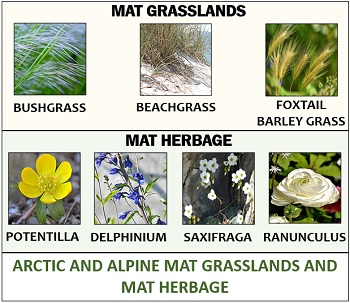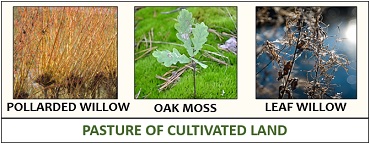Mesophytes represent the group of plants that can neither grow in the complete aquatic habitat nor the dry or water-scarce conditions. They are the land plants showing features similar to both hydrophytes and xerophytes.
They grow under favourable conditions, where the concentration of water and temperature are not too high and not too much low. Both the vascular and mechanical tissues are highly developed and differentiated in mesophytic plants.
Mesophyte plants require stable atmospheric conditions or temperate zone, where the conditions are not too dry and wet. In this post, we will discuss the meaning, examples, characteristics, adaptations of the mesophytes.
Content: Mesophytes
Mesophytes Meaning
Mesophytes refer to the community of terrestrial plants, which can neither adjust in too wet nor in water-scarce conditions. In simple words, they require a moderate amount of hot and humid climatic conditions. Mesophyte plants inhabit the soil that provides an average dry-wet environment for overall growth.
Mesophytes constitute the largest ecological community of land plants. It includes two significant communities, depending upon the ecological conditions, namely the community of grasses and herbs and the community of woody plants.
Mesophytes Examples
Mesophytes are a group of plant species that include two major communities.
The Community of Grasses and Herbs
It includes perennial grasses and herbs, which are further classified into:
- The Arctic and alpine mat grasslands and mat herbage
- Meadow
- Pasture on cultivated land.
The Arctic and alpine mat grasslands and mat herbage represent a particular group of mesophytes that are ubiquitous in Polar Regions and mountain tops. They include small-sized soft shrubs.
The mat grasslands include members of the Gramineae family, and the examples are dicot herbs like Ranunculus, Saxifraga, Delphinium, Potentilla etc.

Meadow represents an intermediate link between the mesophytes and hydrophytes, and it requires 60-83% of moisture content. It includes the members belonging to the Compositae, Papilionate etc.
Pasture on cultivated land has a shorter period of vegetation, where the population or density of the plants is disturbed by grazing. It involves dicot herbs, grasses and mosses.

The Community of Woody Plants
It includes bushlands and forests. The community of woody plants is further classified into:
- Mesophytic bushlands
- Deciduous forests
- Evergreen forests.
In mesophytic bushlands, the temperature is not too favourable for the forest plants but much feasible for the mat herbage vegetation, including plants like Arabis, Salix, Lathyrus, etc.

Deciduous forests are distributed in the temperate, cold or tropical regions where the annual rainfall is upto 80-150 cm. They are characterized by the periodic defoliation of leaves after every 5-8 months of foliation. They include Betula birch forest, Quercus oak forest etc.

Evergreen forests are distributed in tropical and sub-tropical regions. They are common in the cold temperate zone of the Southern Hemisphere.
- Sub-tropical evergreen forests are found in areas with heavy rainfall, and the plants reach a length of 30 metres like the montane forest, pine forest etc.
- Tropical evergreen forests are found in low lying regions with an annual rainfall of 180 cm or more, and the plants are 40-50 metres in height like palm forest etc.
Characteristics
Roots
Mesophytes contain a highly developed and branched root. Unlike hydrophytes, the roots comprise a root cap, which protects the root tip from degeneration and promotes geotropic movement. They can develop perennating organs like corms, rhizomes and bulbs to store food and water.
The roots of monocot mesophytes comprise a cluster of the fibrous root system for the absorption of water, while the roots of dicot mesophytes comprise a well-developed tap root system. The root hairs are present abundantly for uptaking the water and minerals from the soil.
Stems
Mesophyte plants contain wide, linear, branched, and hard stems, which can be herbaceous or woody. They are generally aerial and profusely branched.
The stem comprises an extensive network of mechanical and conductive tissues, which mediate water and minerals conduction all inside the plant body.
Leaves
Mesophytes consist of large, broad, narrow leaves with varying shapes and sizes. The dicotyledonous leaves of mesophytes include many stomata on the lower leaf surface and few or none on the upper leaf surface.
The stomata of monocotyledonous leaves are uniformly distributed on both sides of a leaf and perform a significant role in the evaporation of excess water.
Cuticle
A protective waxy cuticle surrounds the aerial parts of the plant body and prevents excessive transpiration. Besides that, it also protects the internal tissues against physical, chemical, ecological or mechanical stresses.
Water Supply
Mesophytes require a more or less continuous water supply but undergo hardship in extreme conditions, as they lose water rapidly. Thus, they suffer water and temperature stresses.
Hydathodes
Mesophyte plants that grow in the rainy climate possess an especial organ hydathode, which opens without the guard cells. The excessive water exudes out of hydathodes in the form of droplets by the process of guttation.
Adaptations of Mesophytes
- Leaves are comparatively thin and large, and they also increase the surface area for the absorption of light energy or increases the rate of photosynthesis.
- Waxy cuticle encircles the epidermis, and it helps to combat the situation of excessive water loss by the leaves.
- Mesophylls are developed extensively and differentiated to aid gaseous exchange between the plants and the surrounding.
- Vascular bundles possess well-developed xylem and phloem connective tissues. Xylem facilitates the absorbtion of water in plants (from the roots to leaves). Phloem helps in the conduction of organic minerals all around the plants. The vascular bundles allow the plants to keep water balance by enabling the conduction of water and minerals from the leaves to all other parts of the mesophytic plants.
- The root system in mesophytes possesses well-developed roots (generally grow deep inside the soil), providing anchorage to the plants. It also allows efficient water and mineral absorption from the surrounding soil. Besides this, a root system also possesses some accessory structures like root hairs and root cap.
- Stomata are generally present in the lower leaf surface, which slow down excessive evaporation. The stomata tend to open all the time unless the plant experiences extreme water loss.
Conclusion
Therefore, we can conclude that the mesophytes are the group of plant system that grows under an intermediate range of temperature and moisture and act as a connecting link between the hydrophytes and xerophytes.

thank you very much for helping me out
This site is so amazing, I got to like it. Bravo!
Thank u very much, I really liked it!!